Gaura – a whirl of tiny butterflies
Movement is important in a garden. It lends an informal atmosphere and softens otherwise stiff plantings. Grasses are often used for this, especially taller varieties but a few perennials are also perfectly suited for the job and one of the best is whirling butterflies (Gaura lindheimeri). The common name is a perfect description for these fluttering white flowers which are in constant movement on tall wiry stems. (Other common names include wand flower and bee blossom).
The species has white flowers, flushed with pink which emerge all summer long from soft pink buds giving a hazy bicolor effect. In form it resembles a large lavender with a basal clump of narrow foliage in mid green from which rises a fountain of 3-4’ flowering stems. Each plant easily fills a 3’ diameter space – good value from a $10 plant! However there are many other cultivars now available in various sizes and colors. Here is just a sampling;
- 'Passionate Rainbow'; variegated burgundy, pink, creamy white and gold foliage, mid pink flowers, upright habit, 2’. Zones 7-9
- 'Siskiyou Pink'; green foliage, pink flowers, fountain, 2-3’. Zones 5-9
- 'Crimson Butterflies'; a recent hybrid from ‘Siskiyou Pink’ with burgundy foliage, deep pink flowers, upright habit, dwarf at 2’. Zones 5-10
- ‘Dauphine’; the giant! Green foliage, pink and white flowers, 5-7’ fountain. Zones 5-9
At first glance whirling butterflies may seem ideally suited to a casual cottage garden and indeed I have used them that way. Their delicate appearance softens stiffer companions such as coneflowers (Echinacea sp.) and the soft pink and white color scheme is beautiful, lasting for many months. In such an environment it is a ‘mingler’.
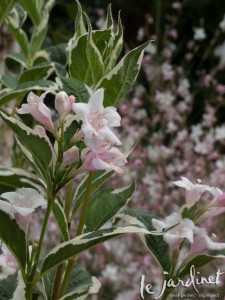
'Magical Fantasy' weigela is enhanced by the dreamy pink and white backdrop of the similarly colored whirling butterflies
In my current garden I have used it to surround a whitebarked Himalayan birch (Betula utilis var. jacquemontii) which enhances the already stunning white tree bark. These adaptable perennials also make a great background plant for the green and white variegated ‘Magical Fantasy’ weigela (Weigela florida 'Kolsunn')Unlike older cultivars this weigela has crisp white margins to its leaves – perfect for combining with whirling butterflies. Tubular pink flowers on the shrub further strengthen the association with either white or pink cultivars of the perennial.
Silver, purple and blue foliage or flowers also form easy companions. Blue ‘Rozanne’ geranium works well as the two weave in and out of one another and billowing ‘Silver Mound’ wormwood (Artemisia schmidtiana 'Silver Mound') adds a shimmery touch.
Shorter cultivars are ideal for using as the ‘thriller’ in container plantings or even in a hanging basket. For both of these designs I rely heavily on good foliage so find the deep pink or variegated foliage forms of whirling butterflies especially useful.
What do they need to thrive? Very little. They are drought tolerant and deer resistant – two of my top priorities. Mine have barely had any water this summer and look amazing. Be careful not to add excessive mulch or compost around the crowns and avoid overly rich soil which stays wet in winter; just average, well drained soil is fine. Other than that, full sun and a chair nearby to enjoy the steady drone of bees which get drunk daily on the pollen!
One key point to remember is about pruning. Being a woody perennial it retains a twiggy structure after the leaves fall in autumn. Do not cut this down. Wait until spring and look to see where the uppermost buds are on the stems and cut just above those. The twigs help protect the crown during the winter. I find that there is usually fresh basal growth in spring as well so the plant quickly regains its former size.
Some cultivars seem to self-seed more than others but extras are easy to pull up. there is no need to deadhead.
How many do you have room for?
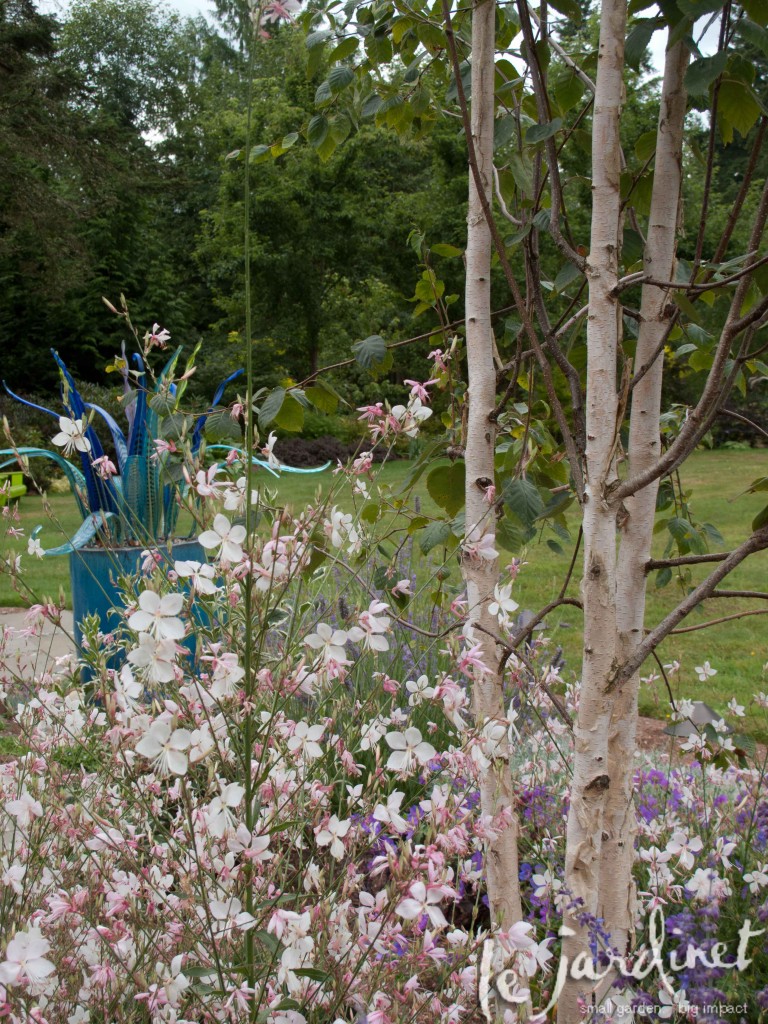
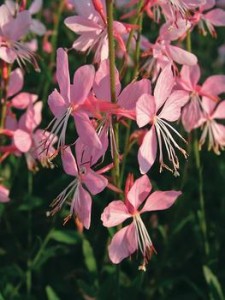
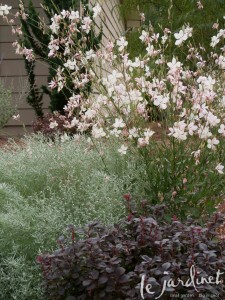
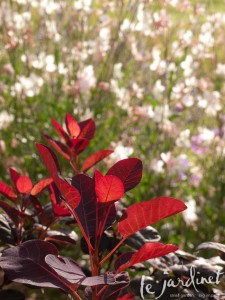
Great post Karen, very handy tips there and suggestions on which ones to look out for!
Thanks guys!
I love gaura but have failed twice with it. Could a third try be successful? Maybe in a pot. I am definitely jealous of yours.
I did really well with it in our last home so am hopeful…! I've planted them high and in the best soil I have. I have noticed that in the past I have had better success with the species than some of the newer hybrids. I'm surprised at the variety in hardiness between them
Gaura is a gorgeous plant. I thought Whirling Buttflies was a cultivar name. However, it has been a long time since I tried to grow it and found that I didn't have enough sun. I wish I could have it with a white barked birch which I also can't grow because of too much heat!!!
Whirling butterflies may be a cultivar name but like so many common names gets muddled along the way. Yes it does need full sun so you'll have to enjoy it from afar in my garden.
I have some friends who have this plant and love it. When I visit them, I always comment on it and take note of it for my collection of plants. Once I reach home I have forgotten all about it. It is now on the list. Thanks for the tip on pruning…very helpful.
Funny Michelle – maybe we need to send emails to one another in spring to remind us what we said we were going to do!
Hi Karen, I have a new gaura in my "holding" bed waiting for spring to be planted out in the garden. I had a gaura in the past, but planted it in a spot where it got crowded out. I will try to place it better this time around and will keep some of your suggestions for companions in mind.
Jennifer, it seems that one needs to find a compromise between giving it space but also giving it friends to 'lean' on for support – especially the taller varieties. Growing it among roses and dahlias are popular options.
I love love love gaura, Karen! Watching bees make the flower stems bob would almost be hypnotizing if it weren't so entertaining. Beautiful combination with the white birch, and with the artemisia. Here it's often used to soften the effect of big yuccas and other "structural" plants.
The bees seem to love Gaura even more than the lavender! Great idea to combine it with Yucca
Karen, I too love this plant. I'm curious how you've made it successful with a birch (which I assume likes lots of water) since it's a low-water-requirements perennial. The best area I've planted it in for a client is a well-drained, very hot strip of a small planting bed between an asphalt driveway and a patio. Go figure.
Interesting point about the birch isn't it? Our soil is fairly moisture retentive but not saturated in that area. The birch seems to get enough water to do well and the Gaura are planted somewhat high so they manage quite well together.
[…] this selection is said to grow to 3-4' tall and wide and be hardy in zones 4-8. Click here to see how it looked in summer – […]
I've really been enjoying your photos and helpful garden information. I was wondering if you could tell me the name of the beautiful turquoise & blue bromeliad-like plant (or perhaps 2 different plants) in a turquoise container. I love the container, as well, and if you have purchase information for it, I would be very grateful. Thank you.
Wendy Florin
Wendy thatbromeliad looking plant is a glass sculpture made by Seattle artist Jesse Kelly http://www.jessekellyglass.com . The container is made by Le Beau-a quick online search will pull up wholesale info but their pots are sold throughout the USA. Glad you like them!